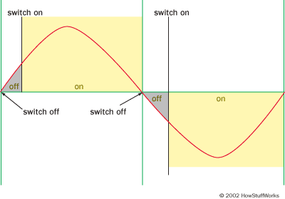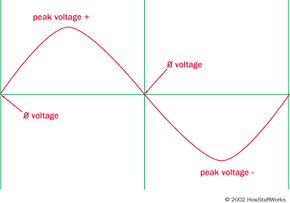The New and Improved Way
Instead of diverting energy from the light bulb into a resistor, modern resistors rapidly shut the light circuit off and on to reduce the total amount of energy flowing through the circuit. The light bulb circuit is switched off many times every second.
The switching cycle is built around the fluctuation of household alternating current (AC). AC current has varying voltage polarity -- in an undulating sine wave, it fluctuates from a positive voltage to a negative voltage. To put it another way, the moving charge that makes up AC current is constantly changing direction. In the United States, it goes through one cycle (moving one way, then the other) 60 times a second. The diagram below shows this sixtieth-of-a-second cycle.
Advertisement
A modern dimmer switch "chops up" the sine wave. It automatically shuts the light bulb circuit off every time the current reverses direction -- that is, whenever there is zero voltage running through the circuit. This happens twice per cycle, or 120 times a second. It turns the light circuit back on when the voltage climbs back up to a certain level.

This "turn-on value" is based on the position of the dimmer switch's knob or slider. If the dimmer is turned to a brighter setting, it will switch on very quickly after cutting off. The circuit is turned on for most of the cycle, so it supplies more energy per second to the light bulb. If the dimmer is set for lower light, it will wait until later in the cycle to turn back on.
That's the basic concept, but how does the dimmer actually do all of this? In the next couple of sections, we'll look at the simple circuitry that makes it work.
